-

新人教版高中英语必修3Unit 3 Diverse Cultures教学设计三
The price is the same as(the price was)before the war.价格与战前相同。(4)定语从句中的“关系代词+助动词be”可以省略。The ticket(that/which was)booked by his sister has been sent to him.他妹妹订的那张票已送到了他那里。Step 5 PracticeActivity 3(1) Guide students to complete the four activities in the Using Structures part of exercise book, in which activities 1 and 2 focus on ellipsis in dialogue answers, activity 3 focus on signs and headlines, two typical situations where ellipsis is used, and activity 4 focus on ellipsis in diary, an informal style.(2) Combine the examples in the above activities, ask students to summarize the omitted situations in groups, and make their own summary into a poster, and post it on the class wall after class to share with the class.(This step should give full play to the subjectivity of students, and teachers should encourage students to conclude different ellipsis phenomena according to their own understanding, they can conclude according to the different parts omitted in the sentence.)Step 6 Homework1. Understand and master the usages of ellipsis;2. Finish the other exercises in Using structures of Workbook.1、通过本节内容学习,学生是否理解和掌握省略的用法;2、通过本节内容学习,学生能否根据上下文语境或情景恢复句子中省略的成分,体会使用省略的效果;3、通过本节内容学习,学生能否独立完成练习册和导学案中的相关练习。

新人教版高中英语必修3Unit 3 Diverse Cultures教学设计二
(2)Consolidate key vocabulary.Ask the students to complete the exercises of activity 6 by themselves. Then ask them to check the answers with their partners.(The first language:Damage of the 1906 San Francisco earthquake and fire.A second language: Yunnan - one of the most diverse provinces in China).Step 5 Language points1. The teacher asks the students to read the text carefully, find out the more words and long and difficult sentences in the text and draw lines, understand the use of vocabulary, and analyze the structure of long and difficult sentences.2. The teacher explains and summarizes the usage of core vocabulary and asks the students to take notes.3. The teacher analyzes and explains the long and difficult sentences that the students don't understand, so that the students can understand them better.Step 6 Homework1. Read the text again, in-depth understanding of the text;2. Master the use of core vocabulary and understand the long and difficult sentences.3. Complete relevant exercises in the guide plan.1、通过本节内容学习,学生是否理解和掌握阅读文本中的新词汇的意义与用法;2、通过本节内容学习,学生能否结合文本特点了解文章的结构和作者的写作逻辑;3、通过本节内容学习,学生能否了解旧金山的城市风貌、文化特色,以及加利福尼亚州的历史,体会多元文化对美国的影响。

新人教版高中英语必修3Unit 3 Diverse Cultures教学设计四
该板块的活动主题是“介绍一个有显著文化特征的地方”( Describe a place with distinctive cultural identity)。该板块通过介绍中国城继续聚焦中国文化。本单元主题图呈现的是旧金山中国城的典型景象, Reading and Thinking部分也提到中国城,为该板块作铺垫。介绍中国城的目的主要是体现中国文化与美国多元文化的关系,它是美国多元文化的重要组成部分。中国城也是海外华人的精神家园和传播中国文化的重要窗口,外国人在中国城能近距离体验中国文化。1. Read the text to understand the cultural characteristics of Chinatown in San Francisco and the relationship between Chinese culture and American multiculturalism;2. Through reading, learn to comb the main information of the article, understand the author's writing purpose and writing characteristics;3. Learn to give a comprehensive, accurate, and organized description of the city or town you live in;Learn to revise and evaluate your writing.Importance:1. Guide the students to read the introduction of Chinatown in San Francisco and grasp its writing characteristics;2. Guide students to introduce their city or town in a comprehensive, accurate and organized way;3. Learn to comb the main information of the article, understand the author's writing purpose, and master the core vocabulary.
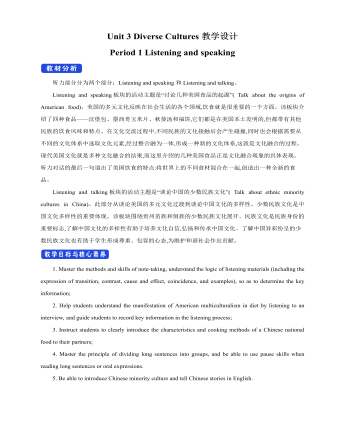
新人教版高中英语必修3Unit 3 Diverse Cultures教学设计一
Activity 81.Grasp the main idea of the listening.Listen to the tape and answer the following questions:Who are the two speakers in the listening? What is their relationship?What is the main idea of the first part of the listening? How about the second part?2.Complete the passage.Ask the students to quickly review the summaries of the two listening materials in activity 2. Then play the recording for the second time.Ask them to complete the passage and fill in the blanks.3.Play the recording again and ask the students to use the structure diagram to comb the information structure in the listening.(While listening, take notes. Capture key information quickly and accurately.)Step 8 Talking Activity 91.Focus on the listening text.Listen to the students and listen to the tape. Let them understand the attitudes of Wu Yue and Justin in the conversation.How does Wu Yue feel about Chinese minority cultures?What does Justin think of the Miao and Dong cultures?How do you know that?2.learn functional items that express concerns.Ask students to focus on the expressions listed in activity. 3.And try to analyze the meaning they convey, including praise (Super!).Agree (Exactly!)"(You're kidding.!)Tell me more about it. Tell me more about it.For example, "Yeah Sure." "Definitely!" "Certainly!" "No kidding!" "No wonder!" and so on.4.Ask the students to have conversations in small groups, acting as Jsim and his friends.Justin shares his travels in Guizhou with friends and his thoughts;Justin's friends should give appropriate feedback, express their interest in relevant information, and ask for information when necessary.In order to enrich the dialogue, teachers can expand and supplement the introduction of Miao, dong, Lusheng and Dong Dage.After the group practice, the teacher can choose several groups of students to show, and let the rest of the students listen carefully, after listening to the best performance of the group, and give at least two reasons.
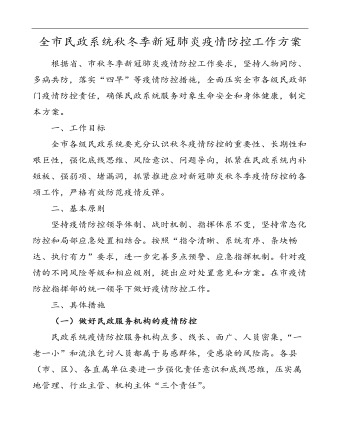
秋冬疫情防控全市民政系统秋冬季新冠肺炎疫情防控工作方案应急预案
一、工作目标全市各级民政系统要充分认识秋冬疫情防控的重要性、长期性和艰巨性,强化底线思维、风险意识、问题导向,抓紧在民政系统内补短板、强弱项、堵漏洞,抓紧推进应对新冠肺炎秋冬季疫情防控的各项工作,严格有效防范疫情反弹。二、基本原则坚持疫情防控领导体制、战时机制、指挥体系不变,坚持常态化防控和局部应急处置相结合。按照“指令清晰、系统有序、条块畅达、执行有力”要求,进一步完善多点预警、应急指挥机制。针对疫情的不同风险等级和相应级别,提出应对处置意见和方案。在市疫情防控指挥部的统一领导下做好疫情防控工作。
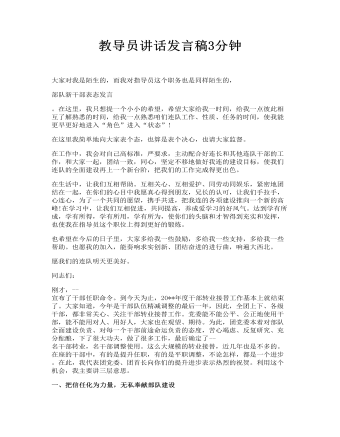
教导员讲话发言稿3分钟
在工作中,我会对自己高标准,严要求,主动配合好连长和其他连队干部的工作,和大家一起,团结一致,同心,坚定不移地做好我连的建设目标,使我们连队的全面建设再上一个新台阶,把我们的工作完成得更出色。在生活中,让我们互相帮助。互相关心、互相爱护、同劳动同娱乐,紧密地团结在一起,在你们的心目中我愿真心得到朋友,兄长的认可,让我们手拉手,心连心,为了一个共同的愿望,携手共进,把我连的各项建设推向一个新的高峰!在学习中,让我们互相促进,共同提高,养成爱学习的好风气。达到学有所成,学有所得,学有所用,学有所为,使你们的头脑和才智得到充实和发挥,也使我在指导员这个职位上得到更好的锻炼。
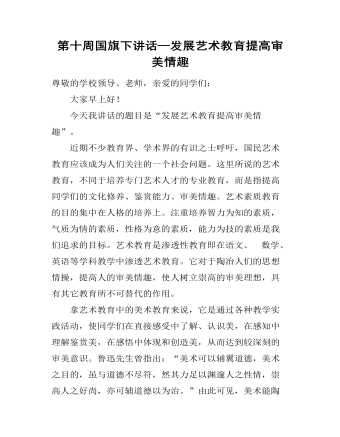
第十周国旗下讲话—发展艺术教育提高审美情趣
尊敬的学校领导、老师,亲爱的同学们:大家早上好!今天我讲话的题目是“发展艺术教育提高审美情趣”。近期不少教育界、学术界的有识之士呼吁,国民艺术教育应该成为人们关注的一个社会问题。这里所说的艺术教育,不同于培养专门艺术人才的专业教育,而是指提高同学们的文化修养、鉴赏能力、审美情趣。艺术素质教育的目的集中在人格的培养上。注重培养智力为知的素质,气质为情的素质,性格为意的素质,能力为技的素质是我们追求的目标。艺术教育是渗透性教育即在语文、 数学、英语等学科教学中渗透艺术教育。它对于陶冶人们的思想情操,提高人的审美情趣,使人树立崇高的审美理想,具有其它教育所不可替代的作用。拿艺术教育中的美术教育来说,它是通过各种教学实践活动,使同学们在直接感受中了解、认识美,在感知中理解鉴赏美,在感悟中体现和创造美,从而达到较深刻的审美意识。鲁迅先生曾指出:“美术可以辅翼道德,美术之目的,虽与道德不尽符,然其力足以渊邃人之性情,崇高人之好尚,亦可辅道德以为治。”由此可见,美术能陶冶人的情操,净化人的心灵,丰富人的感情,让人们心身健康地发展,培养人的高尚品德和审美意识,使人树立正确的人生观……

国企公司主题教育阶段性进展情况总结汇报1500字
深化国企改革行动,补齐重点领域短板弱项。市建投集团将开展整改整治与国企改革三年行动“回头看”有机衔接,紧盯重点领域补短板、强弱项、固底板、扬优势,进一步提高核心竞争力。聚焦价值创造完善业绩考核。重点围绕“一利五率”等核心指标,对标行业优秀企业开展价值创造行动,将利润总额等6个核心指标、科技创新等4个专项指标,一企一策纳入权属企业经营业绩考核责任书,进一步激励权属企业提升价值创造能力。聚焦科技创新健全支持机制。细化落实集团科技发展规划,在研发投入、人才支持、政策保障、体制机制等方面加大改革力度,推动科技创新向轻资产、高效能模式转变。进一步加大研发投入,支持鼓励高新技术企业、专精特新企业更好发挥创新主体作用。建立首席专家制度,加强高端人才培养储备,开展首届首席专家评选,在4个专业领域择优遴选。聚焦减负赋能开展专项治理。
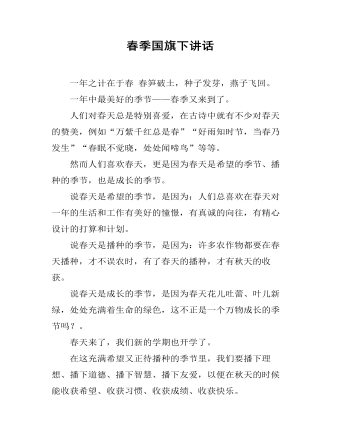
春季国旗下讲话
一年之计在于春 春笋破土,种子发芽,燕子飞回。一年中最美好的季节——春季又来到了。人们对春天总是特别喜爱,在古诗中就有不少对春天的赞美,例如“万紫千红总是春”“好雨知时节,当春乃发生”“春眠不觉晓,处处闻啼鸟”等等。然而人们喜欢春天,更是因为春天是希望的季节、播种的季节,也是成长的季节。说春天是希望的季节,是因为:人们总喜欢在春天对一年的生活和工作有美好的憧憬,有真诚的向往,有精心设计的打算和计划。说春天是播种的季节,是因为:许多农作物都要在春天播种,才不误农时,有了春天的播种,才有秋天的收获。说春天是成长的季节,是因为春天花儿吐蕾、叶儿新绿,处处充满着生命的绿色,这不正是一个万物成长的季节吗?。
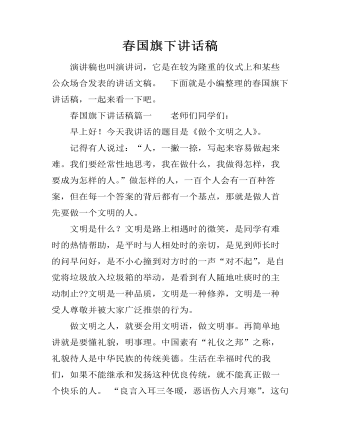
春国旗下讲话稿
演讲稿也叫演讲词,它是在较为隆重的仪式上和某些公众场合发表的讲话文稿。 下面就是小编整理的春国旗下讲话稿,一起来看一下吧。春国旗下讲话稿篇一 老师们同学们:早上好!今天我讲话的题目是《做个文明之人》。记得有人说过:“人,一撇一捺,写起来容易做起来难。我们要经常性地思考,我在做什么,我做得怎样,我要成为怎样的人。”做怎样的人,一百个人会有一百种答案,但在每一个答案的背后都有一个基点,那就是做人首先要做一个文明的人。文明是什么?文明是路上相遇时的微笑,是同学有难时的热情帮助,是平时与人相处时的亲切,是见到师长时的问早问好,是不小心撞到对方时的一声“对不起”,是自觉将垃圾放入垃圾箱的举动,是看到有人随地吐痰时的主动制止??文明是一种品质,文明是一种修养,文明是一种受人尊敬并被大家广泛推崇的行为。做文明之人,就要会用文明语,做文明事。再简单地讲就是要懂礼貌,明事理。中国素有“礼仪之邦”之称,礼貌待人是中华民族的传统美德。生活在幸福时代的我们,如果不能继承和发扬这种优良传统,就不能真正做一个快乐的人。

新人教版高中英语必修3Unit 3 Diverse Cultures-Discovering Useful Structure教学设计
Step 4 PracticeRead the conversation. Find out which words have been left out.Justin: Linlin, I’m going to Guizhou Province next month. I’m super excited! Any recommendations for places to visit?Linlin: Wow, cool! Guizhou is a province with a lot of cultural diversity. Places to visit...well, definitely the Huangguoshu Waterfall first.Justin: What’s special about the waterfall?Linlin: Well, have you ever heard of the Chinese novel Journey to the West ?Justin: Yes, I have. Why ?Linlin: In the back of the waterfall, you will find a cave, which is the home of the Monkey King.Justin: Really? Cool! I’ll definitely check it out.Linlin:And I strongly recommend the ethnic minority villages. You’ll find Chinese culture is much more diverse than you thought.Justin:Sounds great, thanks.Answers:Justin: Linlin, I’m going to Guizhou Province next month. I’m super excited! Do you have any recommendations for places to visit?Linlin: Wow, that’s cool! Guizhou is a province with a lot of cultural diversity. What are some places to visit in Guizhou ? Well, definitely the Huangguoshu Waterfall is the first place to visit in Guizhou Province.Justin: What’s special about the waterfall?Linlin: Well, have you ever heard of the Chinese novel Journey to the West ?Justin: Yes, I have heard of the Chinese novel Journey to the West . Why do you ask if I have heard of the Chinese novel Journey to the West?Linlin: In the back of the waterfall, you will find a cave, which is the home of the Monkey King from Journey to the West.Justin: That’s really true? It’s Cool! I’ll definitely check it out.Linlin:And I strongly recommend the ethnic minority villages on your trip to Guizhou Province. You’ll find Chinese culture is much more diverse than you thought it was.Justin:This all sounds great, thanks.
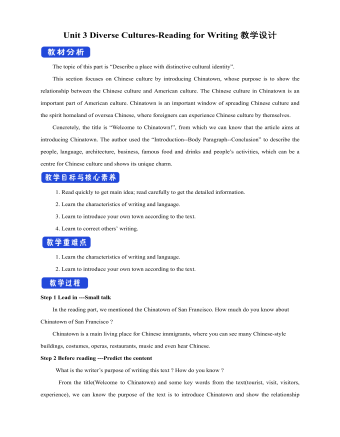
新人教版高中英语必修3Unit 3 Diverse Cultures-Reading for Writing教学设计
The topic of this part is “Describe a place with distinctive cultural identity”.This section focuses on Chinese culture by introducing Chinatown, whose purpose is to show the relationship between the Chinese culture and American culture. The Chinese culture in Chinatown is an important part of American culture. Chinatown is an important window of spreading Chinese culture and the spirit homeland of oversea Chinese, where foreigners can experience Chinese culture by themselves.Concretely, the title is “Welcome to Chinatown!”, from which we can know that the article aims at introducing Chinatown. The author used the “Introduction--Body Paragraph--Conclusion” to describe the people, language, architecture, business, famous food and drinks and people’s activities, which can be a centre for Chinese culture and shows its unique charm.1. Read quickly to get main idea; read carefully to get the detailed information.2. Learn the characteristics of writing and language.3. Learn to introduce your own town according to the text.4. Learn to correct others’ writing.1. Learn the characteristics of writing and language.2. Learn to introduce your own town according to the text.Step 1 Lead in ---Small talkIn the reading part, we mentioned the Chinatown of San Francisco. How much do you know about Chinatown of San Francisco ?Chinatown is a main living place for Chinese immigrants, where you can see many Chinese-style buildings, costumes, operas, restaurants, music and even hear Chinese.Step 2 Before reading ---Predict the contentWhat is the writer’s purpose of writing this text ? How do you know ?From the title(Welcome to Chinatown) and some key words from the text(tourist, visit, visitors, experience), we can know the purpose of the text is to introduce Chinatown and show the relationship between Chinese culture and American culture.
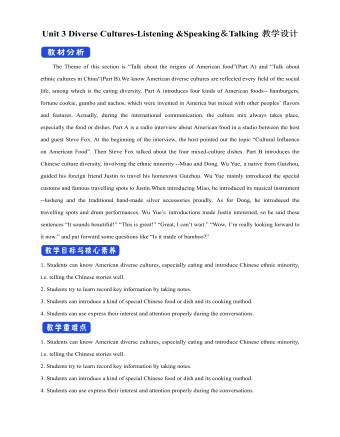
新人教版高中英语必修3Unit 3 Diverse Cultures-Listening &Speaking&Talking教学设计
1. In Picture 1 and Picture 2, where do you think they are from? How do you know?From their wearings, we can know they are from ethnic minority of China--- Miao and Dong.Picture 1, they are playing their traditional instrument lusheng in their traditional costumes.Picture 2. the girls are Miao because they wear their traditional costumes and silver accessory.2. In Picture 3, can you find which village it is? What time is it in the picture?It is Dong village. It is at night. Step 2 While-listeningJustin met a new friend while traveling in Guizhou. Listen to their conversation and complete the summaries below.Part 1Justin and Wu Yue watched some Miao people play the lusheng. The instrument has a history of over 3,000 years and it is even mentioned in the oldest collection of Chinese poetry. Then they watched the lusheng dance. Justin wanted to buy some hand-made silver/traditional accessories as souvenirs. He was told that the price will depend on the percentage of silver. Part 2They will go to a pretty Dong minority village called Zhaoxing. they will see the drum towers and the wind and rain bridges. They may also see a performance of the Grand Song of the Dong people.Step 3 Post-listening---TalkingWork in groups. Imagine Justin is telling some friends about his trip to Guizhou. One of you is Justin and the rest of you are his friends. Ask Justin questions about his trip and experience. The following expressions may help you.
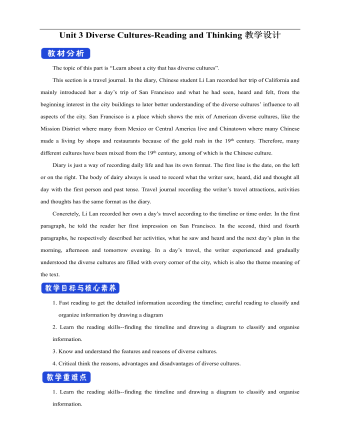
新人教版高中英语必修3Unit 3 Diverse Cultures-Reading and Thinking教学设计
Discuss these questions in groups.Q1: Have you ever been to a place that has a diverse culture ? What do you think about the culture diversity ?One culturally diverse place that I have been to is Harbin, the capital city of Heilongjiang Province. I went there last year with my family to see the Ice and Snow Festival, and I was amazed at how the culture as different to most other Chinese cities. There is a big Russian influence there, with beautiful Russian architecture and lots of interesting restaurants. I learnt that Harbin is called “the Oriental Moscow” and that many Russians settled there to help build the railway over 100 years ago.Q2: What are the benefits and challenges of cultural diversity ?The benefits: People are able to experience a wide variety of cultures, making their lives more interesting, and it can deepen the feelings for our national culture, it is also helpful for us to learn about other outstanding culture, which helps improve the ability to respect others. The challenges: People may have trouble communicating or understanding each other, and it may lead to disappearance of some civilizations and even make some people think “The western moon is rounder than his own.”Step 7 Post reading---RetellComplete the passage according to the text.Today, I arrived back in San Francisco, and it feels good (1) _____(be) back in the city again. The city succeeded in (2)_________ (rebuild) itself after the earthquake that (3)________ (occur) in 1906, and I stayed in the Mission District, enjoying some delicious noodles mixed with cultures. In the afternoon, I headed to a local museum (4)____ showed the historical changes in California. During the gold rush, many Chinese arrived, and some opened up shops and restaurants in Chinatown to earn a (5)_____ (live). Many others worked on (6)______ (farm), joined the gold rush, or went to build the railway that connected California to the east. The museum showed us (7)____ America was built by immigrants from (8)________ (difference) countries and cultures. In the evening, I went to Chinatown, and ate in a Cantonese restaurant that served food on (9)________(beauty) china plates. Tomorrow evening, I’m going to (10)__ jazz bar in the Richmond District. 答案:1. to be 2. rebuilding 3. occurred 4. that 5.living6. farms 7.how 8. different 9. beautiful 10. a
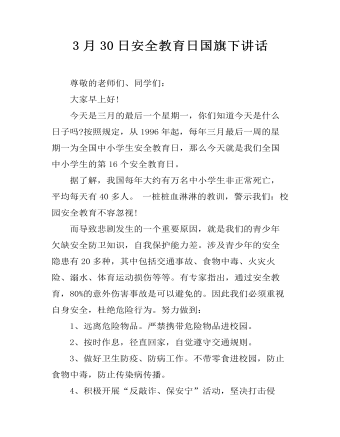
3月30日安全教育日国旗下讲话
尊敬的老师们、同学们:大家早上好!今天是三月的最后一个星期一,你们知道今天是什么日子吗?按照规定,从1996年起,每年三月最后一周的星期一为全国中小学生安全教育日,那么今天就是我们全国中小学生的第16个安全教育日。据了解,我国每年大约有万名中小学生非正常死亡,平均每天有40多人。 一桩桩血淋淋的教训,警示我们:校园安全教育不容忽视!而导致悲剧发生的一个重要原因,就是我们的青少年欠缺安全防卫知识,自我保护能力差。涉及青少年的安全隐患有20多种,其中包括交通事故、食物中毒、火灾火险、溺水、体育运动损伤等等。有专家指出,通过安全教育,80%的意外伤害事故是可以避免的。因此我们必须重视自身安全,杜绝危险行为。努力做到:
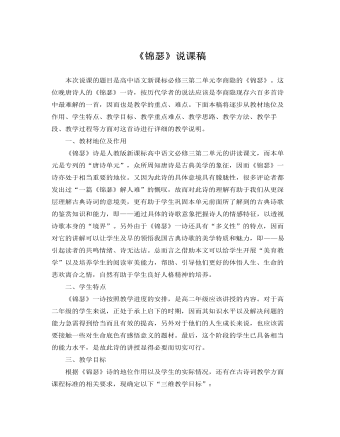
人教版高中语文必修3《锦瑟》说课稿
三、教学目标根据《锦瑟》诗的地位作用以及学生的实际情况,还有在古诗词教学方面课程标准的相关要求,现确定以下“三维教学目标”:(一)知识与技能目标:感受体悟古典诗歌的意境美,发挥合理的主观能动性进行创新性的阅读鉴赏,正确认识意象在诗歌意境中的重要作用。并在上述的基础上提高鉴赏能力和审美情操。(二)过程与方法目标:《锦瑟》诗的讲解采用“引导与自我生成”的方法,从老师的引导开始,以学生的研讨交流再加之教师的总结结束。利用教师引导和师生互动刺激学生的领悟力,提高学生的认知水平与能力。(三)情感态度价值观目标:培养学生在尊重传统文化的基础上热爱祖国自己文化的态度,让学生正确认识古典诗词的精神美。最后在自我感悟中陶冶情操,明心启智。
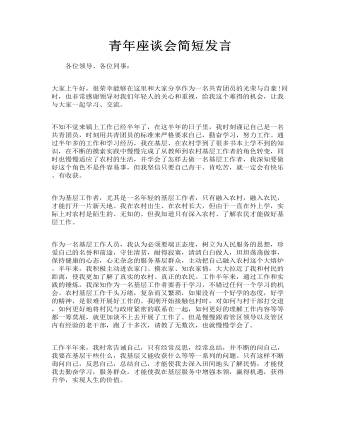
青年座谈会简短发言
不知不觉来镇上工作已经半年了,在这半年的日子里,我时刻谨记自己是一名共青团员,时刻用共青团员的标准来严格要求自己,勤奋学习,努力工作。通过半年多的工作和学习经历,我在基层、在农村学到了很多书本上学不到的知识,在不断的摸索实践中慢慢完成了从教师到农村基层工作者的角色转变,同时也慢慢适应了农村的生活,并学会了怎样去做一名基层工作者,我深知要做好这个角色不是件容易事,但我坚信只要自己肯干、肯吃苦,就一定会有快乐、有收获。
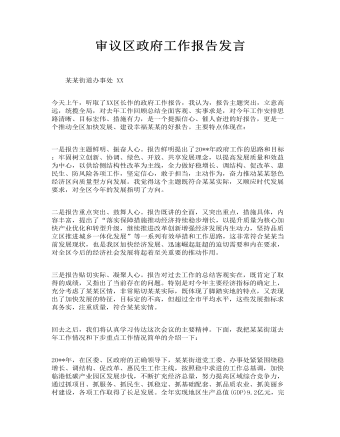
在青年干部座谈会发言
年轻干部要激情奋斗,唯有激情才能成长。激情是工作的灵魂。学习和工作中没有激情就好比身体失去了灵魂,什么事情也不可能真正做好。一年多的信访工作使我的感触颇多,最深的体会是:信访工作很苦,但苦中有乐;信访工作很难,唯艰难处长才能;信访工作很琐碎,唯琐碎才能做细。很庆幸的是,面对这样的信访工作,我依然热爱它,对它充满激情,依然精益求精地去办好每一件信访事项,一步一个脚印地走出为民解难的青春足迹。
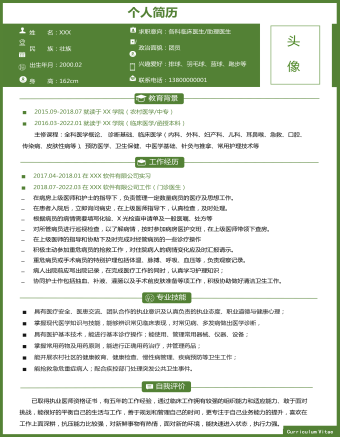
青色临床医生单页简历
n 2017.04-2018.01在XXX软件有限公司实习n 2018.07-2022.03在XXX软件有限公司工作(门诊医生)? 在病房上级医师和护士的指导下,负责管理一定数量病员的医疗及思想工作。? 在患者入院后,立即询问病史,在上级医师指导下,认真检查,及时处理。? 根据病员的病情需要填写化验、X光检查申请单及一般医嘱、处方等? 对所管病员进行巡视检查,以了解病情,按时参加病房医护交班,在上级医师带领下查房。? 在上级医师的指导和协助下及时完成对经管病员的一些诊疗操作? 积极主动参加重危病员的抢救工作,对住院病人的病情变化应及时汇报请示。? 重危病员或手术病员的特别护理包括体温、脉搏、呼吸、血压等,负责观察记录。? 病人出院前应写出院记录,在完成医疗工作的同时,认真学习护理知识;? 协同护士作包括抽血、补液、灌肠以及手术前皮肤准备等项工作,积极协助做好清洁卫生工作。
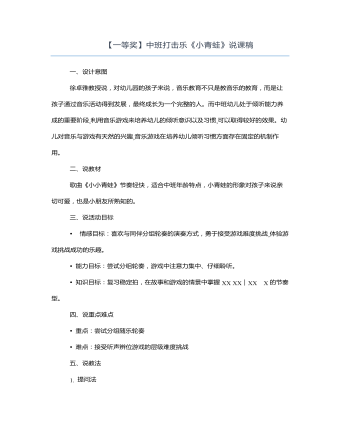
中班打击乐《小青蛙》说课稿
二、说教材歌曲《小小青蛙》节奏轻快,适合中班年龄特点,小青蛙的形象对孩子来说亲切可爱,也是小朋友所熟知的。三、说活动目标? 情感目标:喜欢与同伴分组轮奏的演奏方式,勇于接受游戏难度挑战,体验游戏挑战成功的乐趣。? 能力目标:尝试分组轮奏,游戏中注意力集中、仔细聆听。? 知识目标:复习稳定拍,在故事和游戏的情景中掌握XX XX|XX X的节奏型。四、说重点难点? 重点:尝试分组随乐轮奏? 难点:接受听声辨位游戏的层级难度挑战五、说教法1. 提问法提出有效问题促进幼儿思考,评价幼儿观察效果以及推动幼儿实现预期目标的控制手段。2. 游戏法活动中采用情境性、挑战性、互动性的游戏尽可能最大程度地全方位地激发幼儿的潜在合理需要,激发个体的追求,成长快乐。3. 故事情境法活动中为幼儿创设一个具体形象、生动的学习情境,用合适的方式把幼儿完全带入到情境之中,让幼儿在具体情境的连续不断的启发下有效地进行学习。引起幼儿的注意,激发幼儿的兴趣,唤起他们的求知欲。
